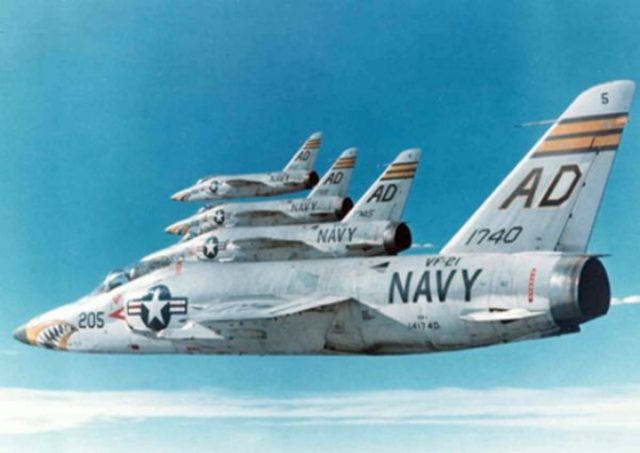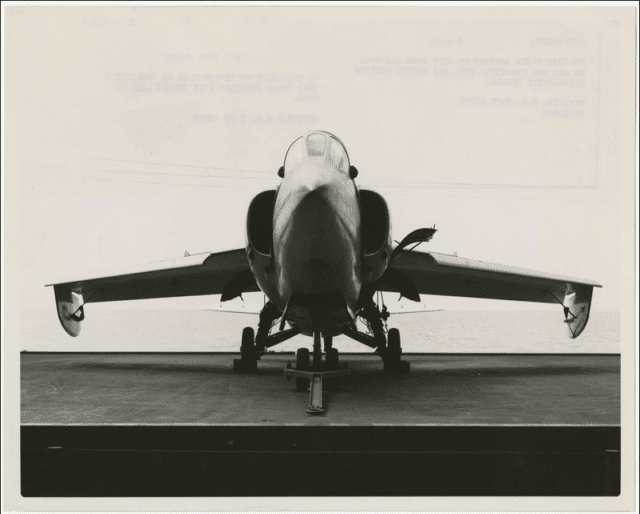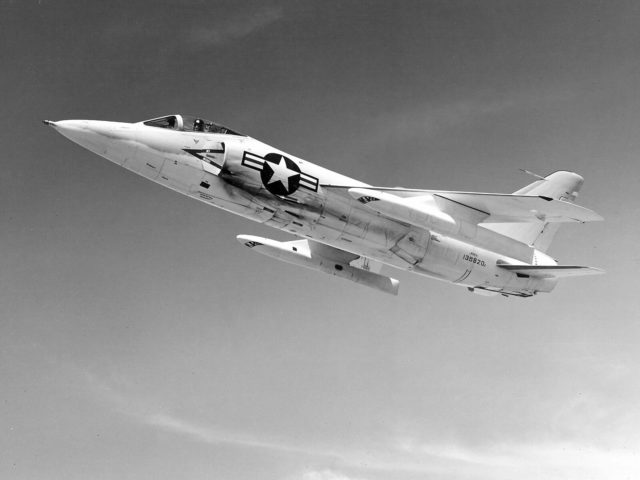How to shoot down a fighter jet…while flying it.
The Grumman F-11 Tiger was a popular US Navy fighter aircraft introduced in 1956. At the time, it was known as the F11F Tiger. Grumman had been working to modernise their Cougar as a part of the Cold War arms race. US aircraft were being outperformed by the swept-wing design of the Soviet’s Mikoyan-Gurevich MiG-15 and Grumman became focused on aerodynamic improvements in order to keep up. The F11F Tiger had a swept-wing design of its own, along with spoilers and leading-edge slats to increase manoeuvrability and folding wings for easy storage on aircraft carriers. The F11F was introduced shortly after the Soviet Union released the first supersonic jet fighter, the Mikoyan-Gurevich MiG-21. The MiG-21 is the most-produced combat aircraft since the Korean War and is still in service in air forces around the world.
The Grumman F-11F Tiger, on the other hand, was retired in the 1960s and is probably best known these days for being the first jet aircraft to shoot itself down.

It was the 21st of September in 1956 when Grumman test pilot Tom Attridge had taken the F11F up over the Atlantic Ocean for a high-speed test of the 20-millimeter Cold Mark-12 cannons. Attridge had flown combat missions with the US Navy in World War II, joining Grumman after he retired from the military. His mission that day was to fly a strafing run at Mach 1 over the Atlantic Ocean.
On that day, the four cannons were each loaded with 125 rounds of inert bullets. Attridge departed the Grumman airbase in New York and flew twenty miles out to sea, climbing to 20,000 feet. Once at the designated area, presumably cleared of all ships, he entered a shallow dive. As he reached Mach 1, he fired a four-second burst at 13,000 feet and then deepened his dive, increasing his thrust with the afterburner. He fired again, this time clearing the gun belts.
The aircraft rattled and the canopy buckled. The pilot immediately pulled back the power and levelled out, reporting that he’d had a bird strike. He reduced his speed, worried that the cockpit glass might cave in. It soon became clear that even at this reduced speed, he did not have enough engine power. He reported a gash on the outboard side of the right intake and that he only had 78% power before the engine ran rough. It wasn’t far to base but he began to realise that he might not make the runway; the engine sounded like “a Hoover vacuum cleaner picking up gravel”.
Attridge still had two miles to run when the engine failed completely. He retracted the landing gear for a forced landing as the aircraft passed over forest. There are definitely Tigers which have been fitted with Martin Baker ejection seats but I don’t know if the early models had one installed. At any rate, he stayed with the aircraft as it descended into the trees, ripping off the right wing. It continued another three hundred feet before coming to a halt just half a mile (800 metres) from the runway. The F11F burst into flames while Attridge cut himself free and climbed out, hampered by a broken leg and three broken vertebrae.
Grumman had already dispatched a Sikorsky S-58 which quickly found him. The rescue helicopter sheared its rotor blades in the process of picking him up to carry him away from the burning crash site.

The investigation of the crash showed that there was no bird strike; the F11F’s windshield, nose cone and right engine intake had been struck by bullets.
It quickly became clear that Attridge had shot himself down. That first four-second burst from the aircraft had suffered from drag, reducing their velocity and trajectory, at the same time as the pilot had increased his acceleration using the afterburners and a steeper dive. The F11F had caught up to the bullets and collided with them. They found an inert bullet in the windshield and another in the nose. Worse, the bullets had bounced into the right engine intake, breaking the fan blades. Investigators found a battered 20mm bullet in the engine’s first compressor stage.
If they’d used live ammunition for the test, Attridge would never have made it to shore.
Check-Six does the maths:
According to Rear Admiral William A. Schoech, assistant chief of the Bureau of Aeronautics for Research and Development, the muzzle velocity of the shells was 3,000-feet a second. Their speed through the air (the muzzle velocity plus the airplane’s speed) was about 4,300 feet- per-second,
“This would be more than 2,000 miles an hour, but their speed was immediately slowed down, because of air resistance. The plane was traveling about 880 miles an hour, better than 100 miles an hour faster than the speed of sound.”
If the airplane had kept its original course, it would have passed by them, but its steepened dive path made it intersect the bullet’s down-curving path. When it hit them, they must have been moving so slowly that the airplane overtook them at a good fraction of its own air speed, which was about as fast as many a newly fired bullet.

The F11F Tiger Navy Bureau number 138620 was written off as a result of the impact damage. Attridge recovered from his injuries and remained at Grumman, becoming a project manager for the Apollo Lunar Module development programme and later the vice president of Grumman Ecosystems. As a result of this crash, the Navy advised their fighter pilots to always turn off course or pull up after firing.
Unbelievably, this is not the only case of a fighter jet shooting itself down. This might become a series.
References:
- That time a Navy jet shot itself down in The NavyTimes
- An Unlucky First… The Shootdown of Tiger #620 on Check-Six
- The Navy’s F11F was so fast it could shoot itself down – and did in We Are The Mighty








Wait… a jet fighter w/o ejection seats? WTF?
from the article: He reported a gash on the outboard side of the right engine and that he only had 78% power before the engine ran rough. It wasn’t far to base but he began to realise that he might not make the runway; the right engine sounded like “a Hoover vacuum cleaner picking up gravel”.
The F11F was a single-engined aircraft but it had twin intakes. The first reference above might be to the starboard intake rather than the engine but the second reference is difficult to interpret.
OH! God, I totally missed this. Yes, the right intake, not the right engine. I’m fixing the article now.
Compressor stall caused by the damage from the ingested bullet?
The hole in the side of the intake would have caused a loss of pressure, a reduction of power and probably a lot of noise.
Anyway, whatever: haste can make waste!
An interesting article.
I’d heard of this as a legend — the plane that was so fast it shot itself down, the computer so fast it needed three HALT instructions in a row to actually stop, … — but never seen verification. I wouldn’t have thought a 20mm bullet would slow down that quickly/much, especially at that altitude, but I’ve never actually calculated drag on anything. Fascinating!
I have no idea how fast aerodynamic drag slows down a bullet. Nor if a jet fighter accelerating in a high-powered dive can gain sufficient speed to overtake its own bullets. How much speed difference between bullets and aircraft, moving in the same direction, would be needed to cause more than superficial damage to windshield and airframe? That aspect, on reflection, sounds a bit dubious. I suppose that the bullets were travelling very fast, at least initially. The windscreens of jet aircraft are very strong and presumably even more so on military fighters.
But an object like a bullet, getting sucked into the engine does not need to hit the spinning compressor at a high speed to do serious damage. The fast rotating impeller or turbine will throw it sideways, causing damage which in turn will cause an imbalance that will be the source of rapidly increasing vibrations. A bird strike can do that sort of damage, a small metal object trown sideways has the potential of exiting through the side of the compressor section of the engine. This explains all the symptoms: vibrations, noises and loss of power. Noises and vibrations because of damage. This also can lead to compressor stall. Compressed air leaving through the side can contribute to strange noises, as well as a serious loss of power. Even overheating as the combustion process is compromised and the air to fuel ratio in the combustion chambers changed and disrupted. I am of course not an engineer, so if more qualified people can cast further light on this it will be appreciated.
Its not the speed it’s the mass as well.
Roger, yes that is correct. And that is why the ingestion of a bullet (small size but relatively high mass) can destroy a jet engine, irrespective of the speed.
I did not write this very clearly: I was wondering what speed difference between the bullets and the aircraft would be needed to cause damage to the airframe. Bullets and aircraft were moving at high speed, but in the same direction. So if the aircraft had been overtaking the bullets at a small speed difference, the only real damage could have been to the engine.
Roger is right: a bullet has the potential to destroy an engine running at high speed; even during a run-up when parked, engineers must take precautions to prevent “FOD”.